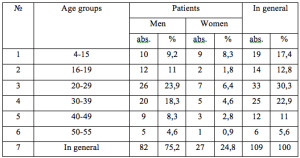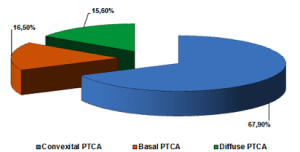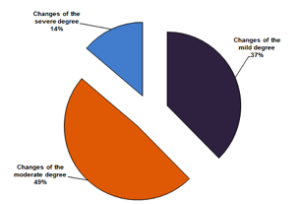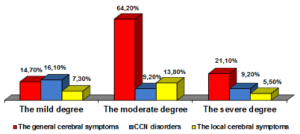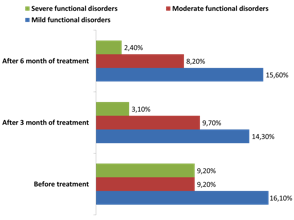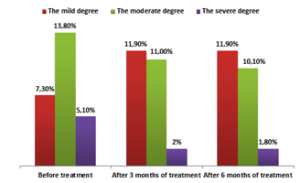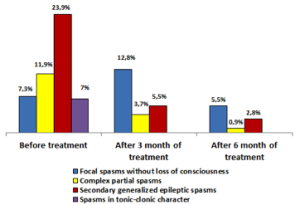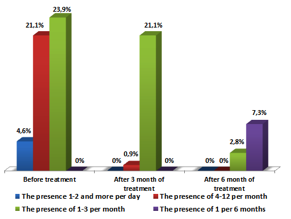THE EFFECTIVENESS OF ENDOLUMBAL INSUFFLATION OF OZONE AND PYRACETAM IN THE TREATMENT OF POSTTRAUMATIC CEREBRAL ARACHNOIDITIS
Алиев М.А.1, Мамадалиев А.М.2, Мамадалиева С.А.3
1Старший научный сотрудник-исследователь, 2доктор медицинских наук, 3врач-ординатор,
Самаркандский государственный медицинский институт
ЭФФЕКТИВНОСТЬ ЭНДОЛЮМБАЛЬНОЙ ИНСУФФЛЯЦИИ ОЗОНА И ПИРАЦЕТАМА ПРИ ЛЕЧЕНИИ ПОСТТРАВМАТИЧЕСКИХ ЦЕРЕБРАЛЬНЫХ АРАХНОИДИТОВ
Аннотация
В статье рассмотрено – применение и результаты эндолюмбального инсуффляции озона и пирацетама при лечение посттравматических церебральных арахноидитов. Получены положительные результаты – улучшены клинико-неврологический статус, уменьшены эпилептические приступы.
Ключевые слова: эндолюмбальной, озон, пирацетам, посттравматик, арахноидит.
Aliev M.A.1, Mamadaliev A.M.2, Mamadalieva S.A.3
1Senior researcher, 2Doctor of Medical Sciences, 3Doctor-intern
Samarkand State Medical Institute
THE EFFECTIVENESS OF ENDOLUMBAL INSUFFLATION OF OZONE AND PYRACETAM IN THE TREATMENT OF POSTTRAUMATIC CEREBRAL ARACHNOIDITIS
Abstract
The article about use and the results of endolumbally insufflation of ozone and pyracetam in the treatment of posttraumatic cerebral arachnoiditis. Received the positive results - improved clinical and neurological status, reduced epileptic seizures.
Keywords: endolumbally, ozone, pyracetam, posttraumatic, arachnoiditis.
Year after year due to the modernization of industry and transportation, increase of urbanization the level of traumatism, especially neuro-traumatism has become significantly high. As the result of craniocerebral traumas (CCT) in 45-60% of patients it has been developed different types of invalid groups, partial and full limitations of working activities [1, 8, 9, 10, 13, 15]. CCT is the actual problem of Public Health and Health Policy and it is presented by the following conditions: 1). CCT mostly occurs in physically active youths and in children; 2). It causes high level of mortality, partial and full limitations of patients’ working activities; 3). It is negatively influenced to the demographic process; 4). In order to treat this condition it is required a big public means and permanent public policy provided by government and patients’ relatives [8, 9, 10, 13].
Acute duration of CCT is characterized by the development of severe outcomes, but the basic complications and outcomes are mostly developed in the intermediate and late periods of cerebral traumatic disease. Among outcomes of CCT, posttraumatic cerebral arachnoiditis (PTCA) is mostly occurred [2, 3, 4, 5, 6, 9, 10, 11, 16].
The aim of the study: Clinical manifestation, diagnostic and treatment methods of PTCA in the most cases are going to be a main aspect of discussions among neurosurgeons, nevrologists and psychiatrics. For the present time with the use of the achievments of modern medicine and technics we have the opportunity to improve diagnostic and treatment methods of PTCA. In this article we have studied the effectiveness of treatment of PTCA by the endolumbal insufflation of ozone and pyracetam.
Materials and methods: In this scientific investigation we have analysed clinical-neurological, diagnostic and treatment results of 109 patients with the diagnoses of PTCA admitted to the Neurosurgical Department of the Clinic of Samarkand State Medical Institute during the period of 2008 – 2014. Among patients 82 (75,2%) were men and 27 (24,8%) were women, at the age from 4 to 55 years old (Table 1).
Table 1. Distribution of the patients treated regarding posttraumatic cerebral arachnoiditis due to the indexes of age and sex
It has been determined that the beginning period of the clinical manifestation of PTCA as a result of CCT was from 1 to 3 years. In order to confirm the diagnoses in 88 patients (80,7%) it has been performed computer tomography (CT) and in 21 patients (19,3%) it has been performed magnet-resonance imaging (MRI), electroencephalography (EEG) have been periodically performed to all patients.
All patients have been received the complex treatment course consisting of the neuroprotective medications, nootropics, medications which improve microcirculation, diuretics, desensititive drugs, vitamins of B-group, patients with epilepsy have been received anticonvulsants (convulex, benzonal, carbamazepine, lamitor). In order to have positive results and to increase the effectiveness of treatment in patients with PTCA we have been carried out the elaborated in the clinic endolumbal ozone [5, 7, 12] and insufflation of pyracetam [1, 14].
Therefore in the aseptic conditions and in ordinary manner it has been carried out lumbar puncture with measure of lumbar pressure and according to the indexes of lumbar pressure we carried out evacuation portion of liquor in definite volume (individually 20-50 ml). After it with the use of syringe ozone was taken from medical ozonator (Ozonator 1M) and in the volume of 10-40 sm3 it is endolumbally injected. Then we dissolve 20% solution of pyracetam in 0,9% solution of sodium chloride in order to get 3-5% solution and in the concentration from 200 mg to 1,0 g (due to the patient’s age) it is injected to the lumbar canal. This manipulation has been performed after getting consent of patients’ relatives and clinical discussions. In general ozone and insufflation of pyracetam have been carried out 202 times for 109 patients. During the 10 days of the treatment course insufflation of ozone and pyracetam was performed once in 16 patients (14,7%) and twice in 93 patients (85,3%). The repeated course of ozone and pyracetam insufflation has been carried out after 3-4 months.
Results and discussion: Patients were divided into 3 groups according to the accepted classification: in the 1 group there were 74 (67,9%) patients with covexital PTCA; in the 2 group there were 18 (16,5%) patients with basal PTCA and with PTCA of the posterior cranial fossa; and in the 3 group there were 17 (15,6%) patients with diagnosed of diffuse PTCA (Figure 1).
Fig. 1 – Distribution according to the classification of posttraumatic cerebral arachnoiditis
On the basis of CT and MRI investigations in 37,6% of patients it has been determined posttraumatic CT – changes of the mild degree, in 48,6% of patients it has been determined posttraumatic CT – changes of the moderate degree and in 15 13,8% of patients it has been determined posttraumatic CT – changes of the severe degree [9, 17, 18] (Figure 2).
Fig. 2. – Distribution according to the degree of CT and MRI changes in posttraumatic cerebral arachnoiditis
There have been determined the presence of different developed degrees of the general and local cerebral symptoms, and the presence of epileptic spasms on the basis of clinical-neurological investigation and anamnestic data. According to the character of the developed general cerebral symptoms patients were divided into following groups: in the 1 group there were 14,7% of patients with the mild developed of the general cerebral symptoms, in the 2 group there were 64,2% of patients with the moderate developed of the general cerebral symptoms and in the 3 group there were 21,1% of patients with the severe developed of the general cerebral symptoms.
Among local symptoms according to the degree of disorders of craniocerebral nerves (CCN) patients were divided into the following groups: in the 1 group there were 16,1% of patients with the mild degree of CCN disorders, in the 2 group there were 9,2% of patients with the moderate degree of CCN disorders and in the 3 group there were 9,2% of patients with the rough degree of CCN disorders.
According to the other local symptoms (motor and sensor systems, changes of coordination) patients were divided into the following groups: in the 1 group there were 7,3% of patients with mild degree of the local changes, in the 2 group there were 13,8% of patients with moderate degree of the local changes and in the 3 group there were 5,5% of patients with severe degree of the local changes (Figure 3.).
Fig. 3. – Differential manifestation of posttraumatic cerebral arachnoiditis due to the degree of the observed symptoms
In 54 patients (49,5%) it has been observed epileptic seizures (ES) and due to its character the distribution was in the following manner: in 8 patients (7,3%) it has been observed focal ES (without loss of consciousness), in 13 patients (11,9%) it has been observed complex partial ES, in 26 patients (23,9%) it has been observed secondary generalized partial ES and in 7 patients (6,4%) it has been observed secondary generalized tonic-clonic ES (Table 2). Due to the observed ES patients were divided into the following groups: in 5 patients (4,6%) ES have been observed 1-2 times and more per day; in 23 patients (21,1%) ES have been observed 4-12 times per month and in 26 patients (23,9%) recurrent ES have been observed 1-3 times per month. Due to the duration of the observed ES patients were divided into the following groups: in 5 patients (4,6%) ES have been continued 1-10 seconds, in 42 patients (38,5%) ES have been continued 10-60 seconds and in 7 patients (6,4%) ES have been continued more than 1 minute.Table 2. – Distribution of posttraumatic cerebral arachnoiditis due to the character of the observed epileptic seizures
In the investigated patients there have been studied the catamnesis after the performed treatment course lasted from 3 to 6 months. As the results of investigations in 28 patients (25,7%) after 3 months of treatment general cerebral symptoms have not been observed, in the 1 group of patients the mild degree of general cerebral symptoms have been observed in 22,9% of cases, in the 2 group of patients the moderate degree of general cerebral symptoms have been observed in 40,4% of cases and in the 3 group of patients the severe degree of general cerebral symptoms have been observed in 11% of cases.
As the results of investigations in 44% of cases after 6 months of treatment general cerebral symptoms have not been observed, in the 1 group of patients the mild degree of general cerebral symptoms have been observed in 31,2% of cases, in the 2 group of patients the moderate degree of general cerebral symptoms have been observed in 20,2% of cases and in the 3 group of patients the severe degree of general cerebral symptoms have been observed in 7,3% of cases (Figure 4).
Fig. 4. – Differential manifestation of the general symptoms before and after treatment
During the study of the dynamic of functional disorders of CCN-s after 3 months of treatment mild functional disorders of CCN-s have been observed in 14,3% of patients, moderate functional disorders of CCN-s have been observed in 9,7% of patients and severe functional disorders of CCN-s have been observed in 3,1% of patients, and on the basis of the data after 6 months of treatment in the 1 group of patients mild functional disorders of CCN-s have been observed in 15,6% of cases, in the 2 group of patients moderate functional disorders of CCN-s have been observed in 8,2% of cases and in the 2 group of patients severe functional disorders of CCN-s have been observed in 2,4% of cases (Figure 5.).
After 3 months of treatment the presence of the local symptoms was the following: in the 1 group of patients the presence of the mild local symptoms have been observed in 11,9% of cases, in the 2 group of patients the presence of the moderate local symptoms have been observed in 11% of cases and in the 3 group of patients the presence of the severe local symptoms have been observed in 1,8% of cases, and after 6 months of treatment the presence of the local symptoms was the following: in the 1 group of patients – 11,9%, in the 2 group of patients – 10,1% and in the 3 group of patients – 1,8% of cases (Figure 6.).
Fig. 5. – Differential manifestation of the symptoms of injures of craniocerebral nerves before and after treatment
Fig. 6. – Differential manifestation of local symptoms in posttraumatic cerebral arachnoiditis before and after treatment
During the assessment of the presence of epileptic spasms after 3 months of treatment in 24 patients (22%) it has been observed ES, due to the character of the spasms in 14 patients (12,8%) there have been observed focal ES without loss of consciousness, in 4 patients (3,7%) there have been observed complex partial ES and in 6 patients (5,5%) there have been observed secondary generalized ES. On the basis of the data presented after 6 months of treatment we could say that 10 patients (9,2%) it has been observed ES, among them in 6 patients (5,5%) spasms were in the focal character, in 1 patient (0,9%) ES were in the complex partial character and in 3 patients (2,8%) spasms were in the secondary generalized partial type. ES in tonic-clonic character after 3 and 6 months of treatment were not observed (Figure 7.).
Fig. 7. – Differential manifestation of epileptic seizures in posttraumatic cerebral arachnoiditis due to its character before and after treatment
According to the presence of ES after 3 months of treatment we have had the following dynamic of changes: the presence 1-2 and more recurrent spasms per day have not been observed; the presence of 4-12 spasms per month have been observed in 11 patient (0,9%) and the presence of 1-3 recurrent spasms per month have been observed in 23 patients (21,1%). After 6 months of treatment the presence of 1-2 spasms per day and 4-12 recurrent spasms per month have not been observed, the presence of 1-3 recurrent spasms per month have been observed in 3 patients (2,8%) and the presence of 1 spasm per 6 months have been observed in 8 (7,3%) patients (Figure 8.).
Fig. 8. – Differential manifestation of the amount of epileptic seizures in patients with posttraumatic cerebral arachnoiditis before and after treatment

Fig. 9. – Differential manifestation of epileptic seizures in posttraumatic cerebral arachnoiditis due to duration of spasms before and after treatment
Due to the duration of ES the evaluation results were positive and after 3 months of treatment we have had the following duration of the presented spasms: in 15 patients (13,8%) duration of spasms was 1-10 seconds, in 9 patients (8,3%) duration of spasms was 10-60 seconds, after 6 months of treatment the duration of spasms has become short, so that in 6 patients (5,5%) duration of spasms was 1-10 seconds and in 4 patients (3,7%) duration of spasms was 10-60 seconds. After 3 and 6 months of treatment we have not determined duration of spasms more than 1 minute (Figure 9.). Conclusions. During the assessment of the results of scientific investigation we have come to the following conclusions. During the complex treatment with the use of endolumbar insufflation of ozone with pyracetam in posttraumatic cerebral arachnoiditis the development of the moderate general cerebral symptoms have been decreased on average in 3 times, in a half of patients the presence of general cerebral symptoms have not been observed. It was our achievement. As a result of using endolumbar insufflation of ozone with nootropics the presence of moderate and severe disorders of craniocerebral nerves were decreased in 2 times. After performing of endolumbar insufflation of ozone with pyracetam the number of patients with epileptic seizures have been decreased on average in 5 times:- Due to the character of epileptic seizures we have examined mostly mild types of spasms, tonic-clonic generalized spasms have not been observed at all;
- The presence of epileptic seizures 1-2 times per day and the presence of 4-12 recurrent spasms per month were not examined, the presence of the recurrent epileptic spasms 1-3 times per month was examined in 2,8% of patients and the presence of epileptic seizures 1 time per 6 months was examined in 7,3% of patients;
- Duration of ES was short, in 5,5% of patients the duration of spasms was 1-10 seconds, in 3,7% of patients the duration of spasms was 10-60 seconds and the duration of spasms more than 1 minute was not completely examined.
References
- Agzamov М.К. (1994). Comprehensive assessment of the efficacy of nootropic-ozone therapy in severe traumatic brain injury (The dissertation of candidate of medical sciences), Samarkand State Medical Institute, Uzbekistan, in Russian.
- Aliev M.A., Mamadaliev M.A. Age-clinical features of patients with posttraumatic cerebral arachnoiditis. Materials of 8th Asian Congress of Neurological Surgeons, 2010, Kuala Lumpur, Malaysia, - P.267.
- Aliev M.A., Mamadaliev M.A. The diagnostic importance of the computer and magnet-resonance tomography in posttraumatic cerebral arachnoiditis. Materials of 8th Asian Congress of Neurological Surgeons, 2010, Kuala Lumpur, Malaysia, - P.194.
- Aliev M.A. The importance endolumbal ozone and nootropic insufflation during the postoperative period after evacuation of posttraumatic arachnoidal cysts. Abstract book of European Association of Neurosurgical Societies’ Young Neurosurgeons Meeting, Innsbruck, Austria, 2011., - P.40.
- Bolg’ayev A.B., Madiyarov S.D. (1977). Treatment of chronic arachnoiditis via introduction of ozone in the subarachnoid space. Journal of Neurology and Psychiatry, Moscow, №2. - 227-231, in Russian.
- Gaevaya M.A. (2000). Features vegetovascular paroxysms of posttraumatic cerebral arachnoiditis different localization. - (The dissertation of candidate of medical sciences). / Kharkiv Medical Academy of Postgraduate Education. - Kharkiv, Ukraine, in Russian.
- Dubrovina Y.A. (2007). Endolyumbal introduction of ozone-oxygen mixture in the treatment of traumatic brain injury and its complications: Clinical and neurophysiological evaluation (The dissertation of candidate of medical sciences), Kazan, Russian Federation, in Russian.
- Konovalov N., Likhterman L.B., Potapov A.A. (1998, 2002). Clinical guidelines for traumatic brain injury. Volume № I and III. Moscow, "Antidor", in Russian.
- Konovalov A.N., Potapov A.A., Likhterman L.B., Kornienko V.N., Kravchuk A.D., Okhlopkov V.A., Zakharova N.Y., & Yakovlev S.B. (2012). Reconstructive and minimally invasive surgery of outcomes of craniocerebral injury. Moscow, In Russian.
- KonovalovN., Likhterman L.B., Potapov A.A. Neurotraumatology: directory. - M.: Medicine, 1994. - 415 p, in Russian. .
- Madyarov S.D. (1988). Pathogenesis, diagnosis and surgical treatment of cerebral arachnoiditis. (The dissertation of doctor of medical sciences). - Kiev, Ukraine, in Russian. .
- Madyarov S.D., Bolgaev A.B. Modification method of introducing ozone into the subarachnoid space / Rat. Offer №127 of 04/19/78, issued by the summit in Russian.
- Mamadaliev A.M. (1988). Predicting outcomes of traumatic brain injury in the acute period (The dissertation of doctor of medical sciences), Burdenko Neurosurgery Institute, Russian Federation, in Russian.
- Mamadaliev A.M., Agzamov M.K. (1993). A method for treating severe traumatic brain injury in the acute period (The patent for the invention of the Russian Federation № 5042297/14/023170 on 07/21/93)., in Russian.
- Mamadaliev A.M., Aliev M.A. (2009). The Importance of the Duration Disorders of Consciousness to Prognosis of the Outcome of Cranio-Cerebral Trauma. In Black P. (Eds)., Proceedings of XIV WFNS Congress, Boston, USA.
- Macheret E.L., Samosyuk I.Z., Garkusha L.G. Cerebral arachnoiditis. - K .: Health Protection, 1985.- 168 p., in Russian.
- Firsching R. Early magnetic resonance imaging and CT of brain-stem lesions after severe injury // J. Neurosurg. – 1998/ - V. 89 (5). – P. 707-712.
- Zlader J., Boguslawaka-Staniaszezyk R. Comparadility of CT-tomography and EEG in the evaluation of posttraumatic sequelae (polish) // Neurologia I neurochirurgia polska. – 1993. – Mar. – Apr. – 27 (2). – P. 175-180.

